Progress in Computers
Prestige Lecture delivered to IEE, Cambridge, on 5 February 2004
Maurice Wilkes
Computer Laboratory
University of Cambridge
The first stored program computers began to work around 1950. The one we built in Cambridge, the
EDSAC was first used in the summer of 1949.
These early experimental computers were built by people like myself with varying
backgrounds. We all had extensive experience in electronic engineering and were confident
that that experience would stand us in good stead. This proved true, although we had some
new things to learn. The most important of these was that transients must be treated
correctly; what would cause a harmless flash on the screen of a television set could lead to
a serious error in a computer.
As far as computing circuits were concerned, we found ourselves with an embarass de
richess. For example, we could use vacuum tube diodes for gates as we did in the EDSAC
or pentodes with control signals on both grids, a system widely used elsewhere. This sort
of choice persisted and the term families of logic came into use. Those who have worked in
the computer field will remember TTL, ECL and CMOS. Of these, CMOS has now
become dominant.
In those early years, the IEE was still dominated by power engineering and we had to
fight a number of major battles in order to get radio engineering along with the rapidly
developing subject of electronics.dubbed in the IEE light current electrical
engineering.properly recognised as an activity in its own right. I remember that we had
some difficulty in organising a conference because the power engineers’ ways of doing
things were not our ways. A minor source of irritation was that all IEE published papers
were expected to start with a lengthy statement of earlier practice, something difficult to do
when there was no earlier practice
Consolidation in the 1960s
By the late 50s or early 1960s, the heroic pioneering stage was over and the computer
field was starting up in real earnest. The number of computers in the world had increased
and they were much more reliable than the very early ones . To those years we can ascribe
the first steps in high level languages and the first operating systems. Experimental
time-sharing was beginning, and ultimately computer graphics was to come along.
Above all, transistors began to replace vacuum tubes. This change presented a
formidable challenge to the engineers of the day. They had to forget what they knew about
circuits and start again. It can only be said that they measured up superbly well to the
challenge and that the change could not have gone more smoothly.
Soon it was found possible to put more than one transistor on the same bit of silicon,
and this was the beginning of integrated circuits. As time went on, a sufficient level of
I
�
integration was reached for one chip to accommodate enough transistors for a small
number of gates or flip flops. This led to a range of chips known as the 7400 series. The
gates and flip flops were independent of one another and each had its own pins. They could
be connected by off-chip wiring to make a computer or anything else.
These chips made a new kind of computer possible. It was called a minicomputer. It
was something less that a mainframe, but still very powerful, and much more affordable.
Instead of having one expensive mainframe for the whole organisation, a business or a
university was able to have a minicomputer for each major department.
Before long minicomputers began to spread and become more powerful. The world
was hungry for computing power and it had been very frustrating for industry not to be
able to supply it on the scale required and at a reasonable cost. Minicomputers transformed
the situation.
The fall in the cost of computing did not start with the minicomputer; it had always
been that way. This was what I meant when I referred in my abstract to inflation in the
computer industry ‘going the other way’. As time goes on people get more for their money,
not less.
Research in Computer Hardware.
The time that I am describing was a wonderful one for research in computer hardware.
The user of the 7400 series could work at the gate and flip-flop level and yet the overall
level of integration was sufficient to give a degree of reliability far above that of discreet
transistors. The researcher, in a university or elsewhere, could build any digital device that
a fertile imagination could conjure up. In the Computer Laboratory we built the Cambridge
CAP, a full-scale minicomputer with fancy capability logic.
The 7400 series was still going strong in the mid 1970s and was used for the
Cambridge Ring, a pioneering wide-band local area network. Publication of the design
study for the Ring came just before the announcement of the Ethernet. Until these two
systems appeared, users had mostly been content with teletype-based local area networks.
Rings need high reliability because, as the pulses go repeatedly round the ring, they
must be continually amplified and regenerated. It was the high reliability provided by the
7400 series of chips that gave us the courage needed to embark on the project for the
Cambridge Ring.
The RISC Movement and Its Aftermath
Early computers had simple instruction sets. As time went on designers of
commercially available machines added additional features which they thought would
improve performance. Few comparative measurements were done and on the whole the
choice of features depended upon the designer’s intuition.
In 1980, the RISC movement that was to change all this broke on the world. The
movement opened with a paper by Patterson and Ditzel entitled The Case for the Reduced
Instructions Set Computer.
Apart from leading to a striking acronym, this title conveys little of the insights into
instruction set design which went with the RISC movement, in particular the way it
facilitated pipelining, a system whereby several instructions may be in different stages of
execution within the processor at the same time. Pipelining was not new, but it was new for
small computers
II
�
The RISC movement benefited greatly from methods which had recently become
available for estimating the performance to be expected from a computer design without
actually implementing it. I refer to the use of a powerful existing computer to simulate the
new design. By the use of simulation, RISC advocates were able to predict with some
confidence that a good RISC design would be able to out-perform the best conventional
computers using the same circuit technology. This prediction was ultimately born out in
practice.
Simulation made rapid progress and soon came into universal use by computer
designers. In consequence, computer design has become more of a science and less of an
art. Today, designers expect to have a roomful of, computers available to do their
simulations, not just one. They refer to such a roomful by the attractive name of computer
farm.
The x86 Instruction Set
Little is now heard of pre-RISC instruction sets with one major exception, namely that
of the Intel 8086 and its progeny, collectively referred to as x86. This has become the
dominant instruction set and the RISC instruction sets that originally had a considerable
measure of success are having to put up a hard fight for survival.
This dominance of x86 disappoints people like myself who come from the research
wings.both academic and industrial.of the computer field. No doubt, business
considerations have a lot to do with the survival of x86, but there are other reasons as well.
However much we research oriented people would like to think otherwise. high level
languages have not yet eliminated the use of machine code altogether. We need to keep
reminding ourselves that there is much to be said for strict binary compatibility with
previous usage when that can be attained. Nevertheless, things might have been different if
Intel’s major attempt to produce a good RISC chip had been more successful. I am
referring to the i860 (not the i960, which was something different). In many ways the i860
was an excellent chip, but its software interface did not fit it to be used in a workstation.
There is an interesting sting in the tail of this apparently easy triumph of the x86
instruction set. It proved impossible to match the steadily increasing speed of RISC
processors by direct implementation of the x86 instruction set as had been done in the past.
Instead, designers took a leaf out of the RISC book; although it is not obvious, on the
surface, a modern x86 processor chip contains hidden within it a RISC-style processor with
its own internal RISC coding. The incoming x86 code is, after suitable massaging,
converted into this internal code and handed over to the RISC processor where the critical
execution is performed.
In this summing up of the RISC movement, I rely heavily on the latest edition of
Hennessy and Patterson’s books on computer design as my supporting authority; see in
particular Computer Architecture, third edition, 2003, pp 146, 151-4, 157-8.
The IA-64 instruction set.
Some time ago, Intel and Hewlett-Packard introduced the IA-64 instruction set. This
was primarily intended to meet a generally recognised need for a 64 bit address space. In
this, it followed the lead of the designers of the MIPS R4000 and Alpha. However one
would have thought that Intel would have stressed compatibility with the x86; the puzzle is
that they did the exact opposite.
III
�
Moreover, built into the design of IA-64 is a feature known as predication which
makes it incompatible in a major way with all other instruction sets. In particular, it needs
6 extra bits with each instruction. This upsets the traditional balance between instruction
word length and information content, and it changes significantly the brief of the compiler
writer.
In spite of having an entirely new instruction set, Intel made the puzzling claim that
chips based on IA-64 would be compatible with earlier x86 chips. It was hard to see
exactly what was meant.
Chips for the latest IA-64 processor, namely, the Itanium, appear to have special
hardware for compatibility. Even so, x86 code runs very slowly.
Because of the above complications, implementation of IA-64 requires a larger chip
than is required for more conventional instruction sets. This in turn implies a higher cost.
Such at any rate, is the received wisdom, and, as a general principle, it was repeated as
such by Gordon Moore when he visited Cambridge recently to open the Betty and Gordon
Moore Library. I have, however, heard it said that the matter appears differently from
within Intel. This I do not understand. But I am very ready to admit that I am completely
out of my depth as regards the economics of the semiconductor industry.
AMD have defined a 64 bit instruction set that is more compatible with x86 and they
appear to be making headway with it. The chip is not a particularly large one. Some people
think that this is what Intel should have done. [Since the lecture was delivered, Intel have
announced that they will market a range of chips essentially compatible with those offered
by AMD.]
The Relentless Drive towards Smaller Transistors
The scale of integration continued to increase. This was achieved by shrinking the
original transistors so that more could be put on a chip. Moreover, the laws of physics were
on the side of the manufacturers. The transistors also got faster, simply by getting smaller.
It was therefore possible to have, at the same time, both high density and high speed.
There was a further advantage. Chips are made on discs of silicon, known as wafers.
Each wafer has on it a large number of individual chips, which are processed together and
later separated. Since shrinkage makes it possible to get more chips on a wafer, the cost per
chip goes down.
Falling unit cost was important to the industry because, if the latest chips are cheaper
to make as well as faster, there is no reason to go on offering the old ones, at least not
indefinitely. There can thus be one product for the entire market.
However, detailed cost calculations showed that, in order to maintain this advantage
as shrinkage proceeded beyond a certain point, it would be necessary to move to larger
wafers. The increase in the size of wafers was no small matter. Originally, wafers were one
or two inches in diameter, and by 2000 they were as much as twelve inches. At first, it
puzzled me that, when shrinkage presented so many other problems, the industry should
make things harder for itself by going to larger wafers. I now see that reducing unit cost
was just as important to the industry as increasing the number of transistors on a chip, and
that this justified the additional investment in foundries and the increased risk.
The degree of integration is measured by the feature size, which, for a given
technology, is best defined as the half the distance between wires in the densest chips made
IV
�
in that technology. At the present time, production of 90 nm chips is still building up
Suspension of Law
In March 1997, Gordon Moore was a guest speaker at the celebrations of the
centenary of the discovery of the electron held at the Cavendish Laboratory. It was during
the course of his lecture that I first heard the fact that you can have silicon chips that are
both fast and low in cost described as a violation of Murphy’s law.or Sod’s law as it is
usually called in the UK. Moore said that experience in other fields would lead you to
expect to have to choose between speed and cost, or to compromise between them. In fact,
in the case of silicon chips, it is possible to have both.
In a reference book available on the web, Murphy is identified as an engineer working
on human acceleration tests for the US Air Force in 1949. However, we were perfectly
familiar with the law in my student days, when we called it by a much more prosaic name
than either of those mentioned above, namely, the Law of General Cussedness. We even
had a mock examination question in which the law featured. It was the type of question in
which the first part asks for a definition of some law or principle and the second part
contains a problem to be solved with the aid of it. In our case the first part was to define
the Law of General Cussedness and the second was the problem;A cyclist sets out on a
circular cycling tour. Derive an equation giving the direction of the wind at any time.
The single-chip computer
At each shrinkage the number of chips was reduced and there were fewer wires going
from one chip to another. This led to an additional increment in overall speed, since the
transmission of signals from one chip to another takes a long time.
Eventually, shrinkage proceeded to the point at which the whole processor except for
the caches could be put on one chip. This enabled a workstation to be built that
out-performed the fastest minicomputer of the day, and the result was to kill the
minicomputer stone dead. As we all know, this had severe consequences for the computer
industry and for the people working in it.
From the above time the high density CMOS silicon chip was Cock of the Roost.
Shrinkage went on until millions of transistors could be put on a single chip and the speed
went up in proportion.
Processor designers began to experiment with new architectural features designed to
give extra speed. One very successful experiment concerned methods for predicting the
way program branches would go. It was a surprise to me how successful this was. It led to
a significant speeding up of program execution and other forms of prediction followed
Equally surprising is what it has been found possible to put on a single chip computer
by way of advanced features. For example, features that had been developed for the IBM
Model 91.the giant computer at the top of the System 360 range.are now to be found on
microcomputers
Murphy’s Law remained in a state of suspension. No longer did it make sense to build
experimental computers out of chips with a small scale of integration, such as that
provided by the 7400 series. People who wanted to do hardware research at the circuit
level had no option but to design chips and seek for ways to get them made. For a time,
this was possible, if not easy
Unfortunately, there has since been a dramatic increase in the cost of making chips,
V
�
mainly because of the increased cost of making masks for lithography, a photographic
process used in the manufacture of chips. It has, in consequence, again become very
difficult to finance the making of research chips, and this is a currently cause for some
concern.
The Semiconductor Road Map
The extensive research and development work underlying the above advances has
been made possible by a remarkable cooperative effort on the part of the international
semiconductor industry.
At one time US monopoly laws would probably have made it illegal for US
companies to participate in such an effort. However about 1980 significant and far
reaching changes took place in the laws. The concept of pre-competitive research was
introduced. Companies can now collaborate at the pre-competitive stage and later go on to
develop products of their own in the regular competitive manner.
The agent by which the pre-competitive research in the semi-conductor industry is
managed is known as the Semiconductor Industry Association (SIA). This has been active
as a US organisation since 1992 and it became international in 1998. Membership is open
to any organisation that can contribute to the research effort.
Every two years SIA produces a new version of a document known as the
International Technological Roadmap for Semiconductors (ITRS), with an update in the
intermediate years. The first volume bearing the title ‘Roadmap’ was issued in 1994 but
two reports, written in 1992 and distributed in 1993, are regarded as the true beginning of
the series.
Successive roadmaps aim at providing the best available industrial consensus on the
way that the industry should move forward. They set out in great detail.over a 15 year
horizon. the targets that must be achieved if the number of components on a chip is to be
doubled every eighteen months.that is, if Moore’s law is to be maintained.-and if the cost
per chip is to fall.
In the case of some items, the way ahead is clear. In others, manufacturing problems
are foreseen and solutions to them are known, although not yet fully worked out; these
areas are coloured yellow in the tables. Areas for which problems are foreseen, but for
which no manufacturable solutions are known, are coloured red. Red areas are referred to
as Red Brick Walls.
The targets set out in the Roadmaps have proved realistic as well as challenging, and
the progress of the industry as a whole has followed the Roadmaps closely. This is a
remarkable achievement and it may be said that the merits of cooperation and competition
have been combined in an admirable manner.
It is to be noted that the major strategic decisions affecting the progress of the industry
have been taken at the pre-competitive level in relative openness, rather than behind closed
doors. These include the progression to larger wafers.
By 1995, I had begun to wonder exactly what would happen when the inevitable point
was reached at which it became impossible to make transistors any smaller. My enquiries
led me to visit ARPA headquarters in Washington DC, where I was given a copy of the
recently produced Roadmap for 1994. This made it plain that serious problems would arise
when a feature size of 100 nm was reached, an event projected to happen in 2007, with 70
VI
�
nm following in 2010. The year for which the coming of 100 nm (or rather 90 nm) was
projected was in later Roadmaps moved forward to 2004 and in the event the industry got
there a little sooner.
I presented the above information from the 1994 Roadmap, along with such other
information that I could obtain, in a lecture to the IEE in London, entitled The CMOS
end-point and related topics in Computing and delivered on 8 February 1996.
The idea that I then had was that the end would be a direct consequence of the number
of electrons available to represent a one being reduced from thousands to a few hundred.
At this point statistical fluctuations would become troublesome, and thereafter the circuits
would either fail to work, or if they did work would not be any faster. In fact the physical
limitations that are now beginning to make themselves felt do not arise through shortage of
electrons, but because the insulating layers on the chip have become so thin that leakage
due to quantum mechanical tunnelling has become troublesome.
There are many problems facing the chip manufacturer other than those that arise
from fundamental physics, especially problems with lithography. In an update to the 2001
Roadmap published in 2002, it was stated that the continuation of progress at present rate
will be at risk as we approach 2005 when the roadmap projects that progress will stall
without research break-throughs in most technical areas “. This was the most specific
statement about the Red Brick Wall, that had so far come from the SIA and it was a strong
one. The 2003 Roadmap reinforces this statement by showing many areas marked red,
indicating the existence of problems for which no manufacturable solutions are known.
It is satisfactory to report that, so far, timely solutions have been found to all the
problems encountered. The Roadmap is a remarkable document and, for all its frankness
about the problems looming above, it radiates immense confidence. Prevailing opinion
reflects that confidence and there is a general expectation that, by one means or another,
shrinkage will continue, perhaps down to 45 nm or even less.
However, costs will rise steeply and at an increasing rate. It is cost that will ultimately
be seen as the reason for calling a halt. The exact point at which an industrial consensus is
reached that the escalating costs can no longer be met will depend on the general economic
climate as well as on the financial strength of the semiconductor industry itself.。
Insulating layers in the most advanced chips are now approaching a thickness equal to
that of 5 atoms. Beyond finding better insulating materials, and that cannot take us very far,
there is nothing we can do about this. We may also expect to face problems with on-chip
wiring as wire cross sections get smaller. These will concern heat dissipation and atom
migration. The above problems are very fundamental. If we cannot make wires and
insulators, we cannot make a computer, whatever improvements there may be in the
CMOS process or improvements in semiconductor materials. It is no good hoping that
some new process or material might restart the merry-go-round of the density of transistors
doubling every eighteen months.
I said above that there is a general expectation that shrinkage would continue by one
means or another to 45 nm or even less. What I had in mind was that at some point further
scaling of CMOS as we know it will become impracticable, and the industry will need to
look beyond it.
Since 2001 the Roadmap has had a section entitled emerging research devices on
VII
�
non-conventional forms of CMOS and the like. Vigorous and opportunist exploitation of
these possibilities will undoubtedly take us a useful way further along the road, but the
Roadmap rightly distinguishes such progress from the traditional scaling of conventional
CMOS that we have been used to.
Advances in Memory Technology
Unconventional CMOS could revolutionalize memory technology. Up to now, we
have relied on DRAMs for main memory. Unfortunately, these are only increasing in speed
marginally as shrinkage continues, whereas processor chips and their associated cache
memory continue to double in speed every two years. The result is a growing gap in speed
between the processor and the main memory. This is the memory gap and is a current
source of anxiety. A breakthrough in memory technology, possibly using some form of
unconventional CMOS, could lead to a major advance in overall performance on problems
with large memory requirements, that is, problems which fail to fit into the cache.
Perhaps this, rather than attaining marginally higher basis processor speed will be the
ultimate role for non-conventional CMOS.
Shortage of Electrons
Although shortage of electrons has not so far appeared as an obvious limitation, in the
long term it may become so. Perhaps this is where the exploitation of non-conventional
CMOS will lead us. However, some interesting work has been done.notably by Haroon
Amed and his team working in the Cavendish Laboratory.on the direct development of
structures in which a single electron more or less makes the difference between a zero and
a one. However very little progress has been made towards practical devices that could
lead to the construction of a computer. Even with exceptionally good luck, many tens of
years must inevitably elapse before a working computer based on single electron effects
can be contemplated.
VIII
�
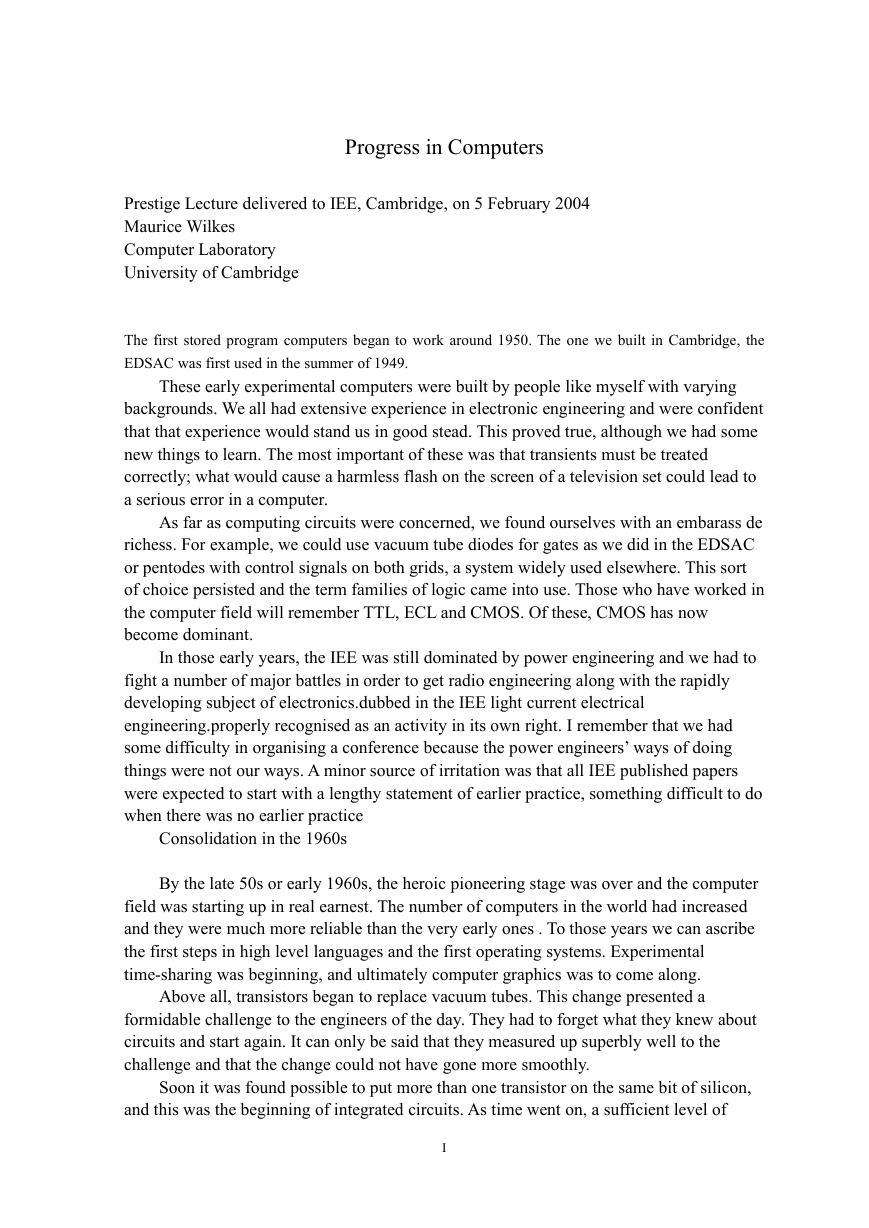
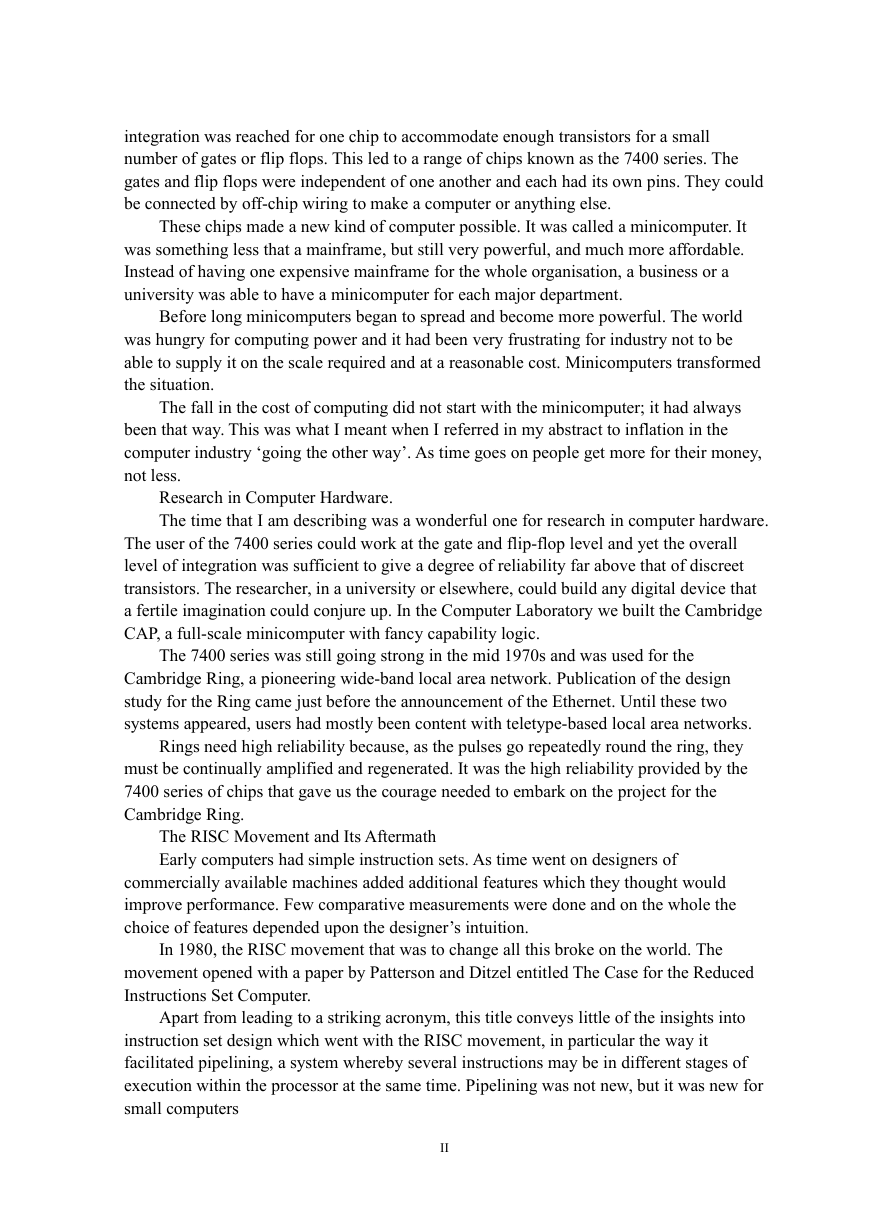

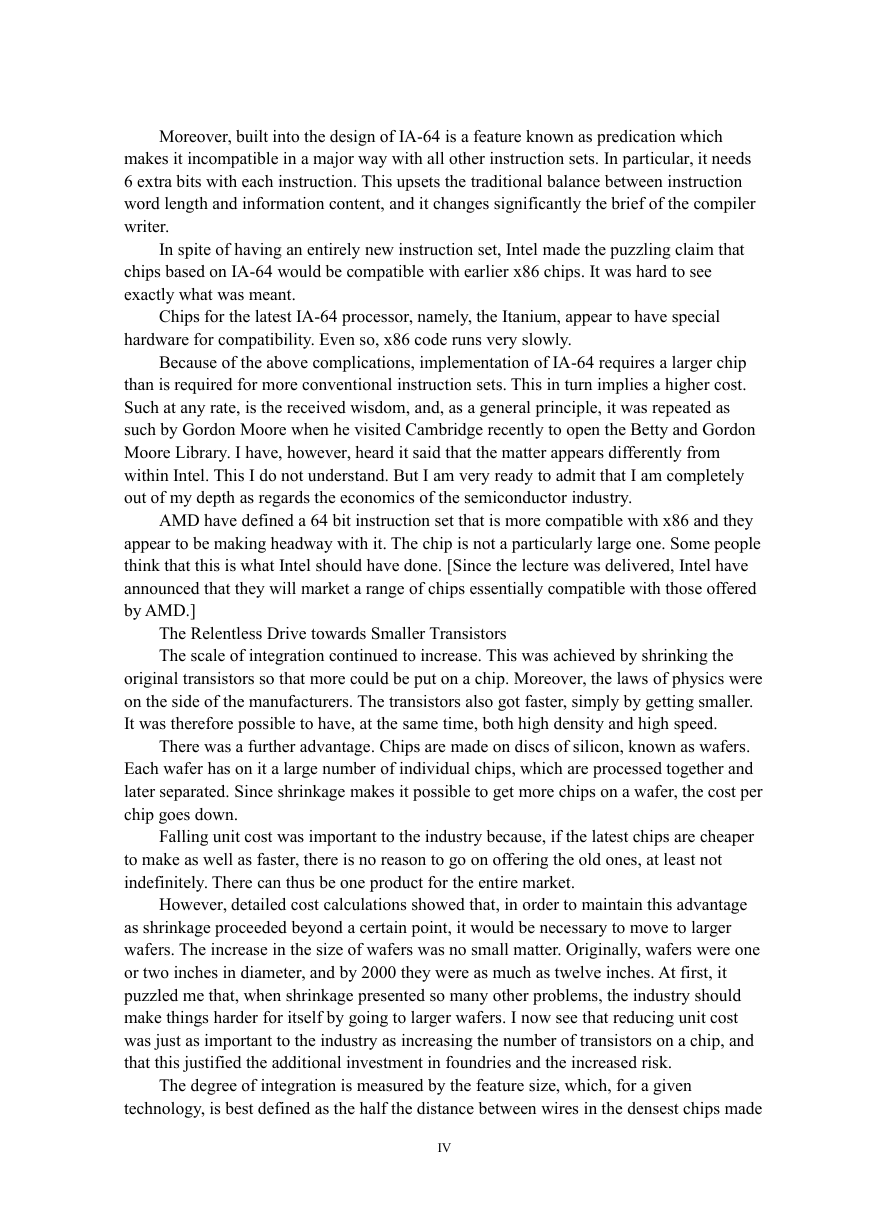
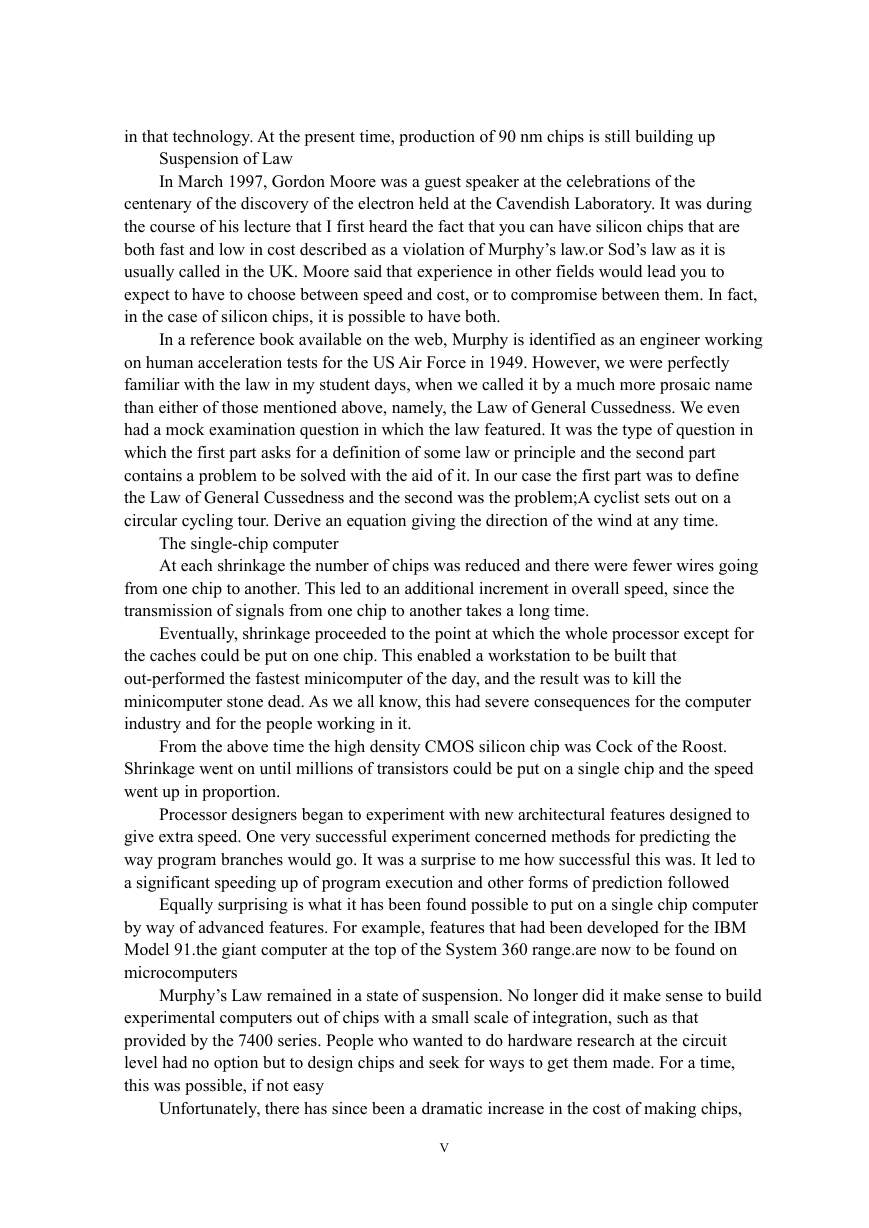
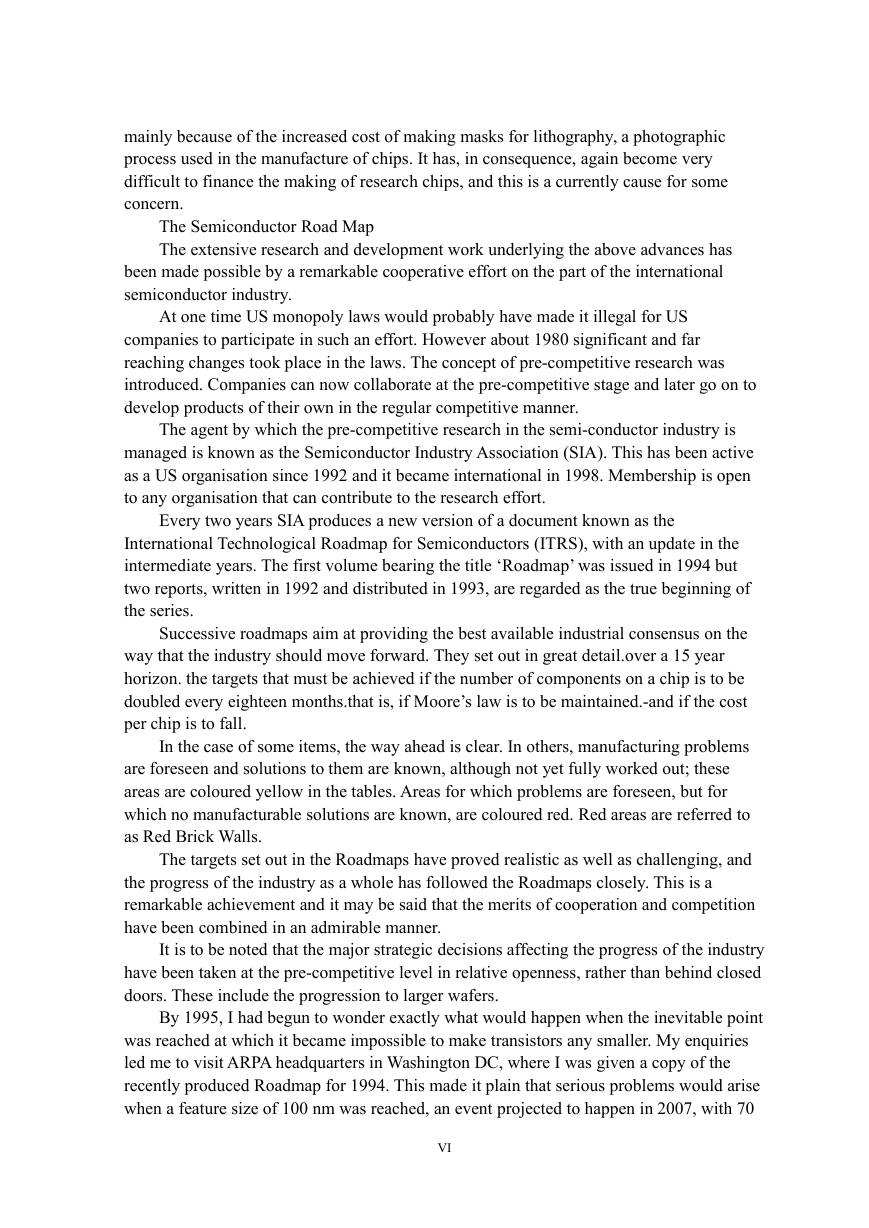
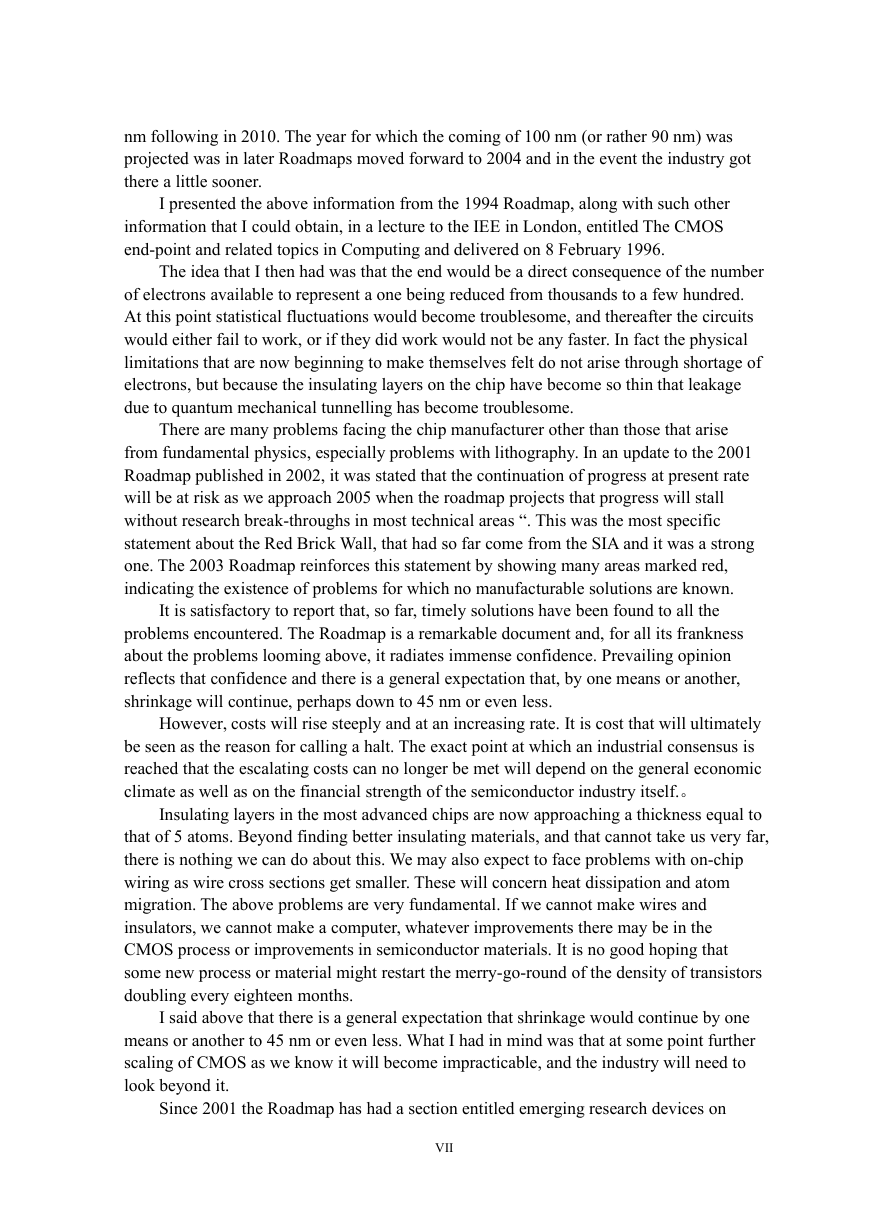
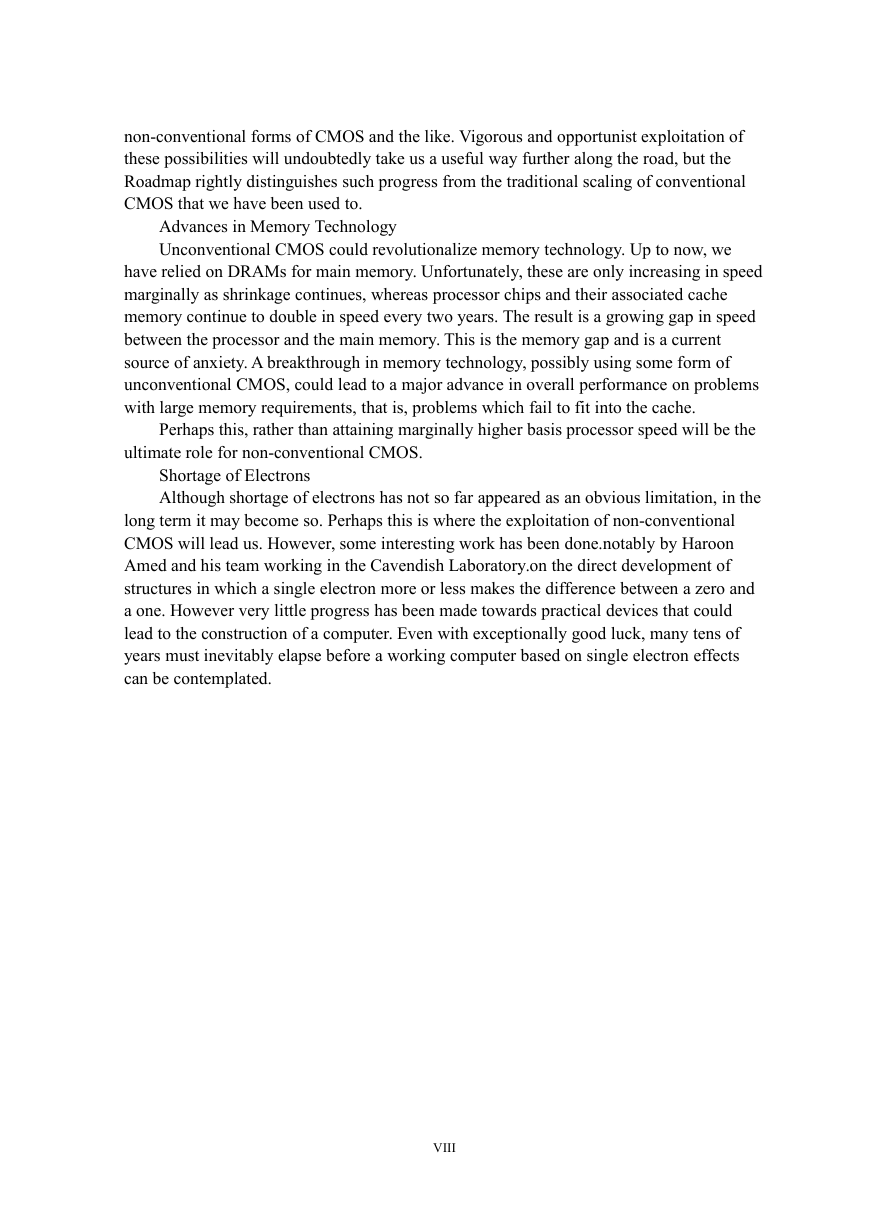








 2023年江西萍乡中考道德与法治真题及答案.doc
2023年江西萍乡中考道德与法治真题及答案.doc 2012年重庆南川中考生物真题及答案.doc
2012年重庆南川中考生物真题及答案.doc 2013年江西师范大学地理学综合及文艺理论基础考研真题.doc
2013年江西师范大学地理学综合及文艺理论基础考研真题.doc 2020年四川甘孜小升初语文真题及答案I卷.doc
2020年四川甘孜小升初语文真题及答案I卷.doc 2020年注册岩土工程师专业基础考试真题及答案.doc
2020年注册岩土工程师专业基础考试真题及答案.doc 2023-2024学年福建省厦门市九年级上学期数学月考试题及答案.doc
2023-2024学年福建省厦门市九年级上学期数学月考试题及答案.doc 2021-2022学年辽宁省沈阳市大东区九年级上学期语文期末试题及答案.doc
2021-2022学年辽宁省沈阳市大东区九年级上学期语文期末试题及答案.doc 2022-2023学年北京东城区初三第一学期物理期末试卷及答案.doc
2022-2023学年北京东城区初三第一学期物理期末试卷及答案.doc 2018上半年江西教师资格初中地理学科知识与教学能力真题及答案.doc
2018上半年江西教师资格初中地理学科知识与教学能力真题及答案.doc 2012年河北国家公务员申论考试真题及答案-省级.doc
2012年河北国家公务员申论考试真题及答案-省级.doc 2020-2021学年江苏省扬州市江都区邵樊片九年级上学期数学第一次质量检测试题及答案.doc
2020-2021学年江苏省扬州市江都区邵樊片九年级上学期数学第一次质量检测试题及答案.doc 2022下半年黑龙江教师资格证中学综合素质真题及答案.doc
2022下半年黑龙江教师资格证中学综合素质真题及答案.doc